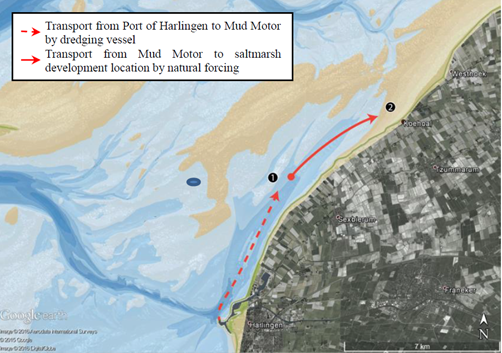Initiation
Accumulation of sediment is common in ports such as the Port of Harlingen. Dredging is required to maintain sufficient water depth for the ships. The dredged sediment is disposed offshore, as close to the port as possible to limit the costs. At the same time, a considerable part of the disposed sediment may return to the port under influence of tidal flow, which increases the maintenance dredging volumes. The goal of the Mud Motor is to re-use the dredged sediment in a beneficial way by stimulation of salt marsh development.
Salt marshes
Young salt marshes are important for the Wadden Sea ecosystem. Salt marshes dampen waves before they reach the shore and thereby contribute to the safety against flooding. Salt marshes are present north of Harlingen but their size is limited. This may either be due to limited mud supply or hydrodynamic conditions being too energetic. Experience with creating quiet hydrodynamic conditions to facilitate salt marsh growth has already been gained in the past. A logical follow-up is to increase the sediment supply by using the sediment available from maintenance dredging in the harbour.
Prefeasibility and Feasibility
Growth of the salt marshes is important to keep pace with sea level rise. Important natural processes that need understanding are deposition of fines on the tidal flats and salt marshes, erosion and compaction of the salt marshes, and vegetation growth. In the project Mud Motor Koehoal, the salt marshes at Koehoal along the northern coast of the Netherlands are studied. The salt marshes are valuable for the ecological functioning of the Wadden Sea, among others for birds (Veldrapportage vogelwaarnemingen bij drone-opnamen Koehoal-Westhoek), and also for protection of the dikes. Important is to understand the dynamics of the salt marshes and which processes are involved with erosion and expansion of the salt marshes. In addition, it is important to understand the transport of sediment from the disposal site through the tidal channels to the tidal flat and salt marsh system. The different processes that transport the sediment and keep the sediment in suspension are important to understand, in particular under different wave conditions and tidal currents.

The efficiency of the Mud Motor depends on a couple of aspects. One aspect is the disposal location offshore of the port. A preliminary study was conducted to assess the most efficient location for disposal of the dredged mud from the Port of Harlingen, with as much as possible deposition on the salt marshes and at the same time a disposal location close to the port (Vergunningaanvraag Natuurbeschermingswet 1998; Van Eekelen et al., 2016).
Another aspect is the timing of disposal, in particular in case of large fluctuations in flow conditions, such as in the Wadden Sea. In the Mud Motor Koehoal, disposal at the selected location is only executed during flood tide, with flow from the disposal location towards the salt marsh.
Site description
Harlingen is a city situated in the northern part of The Netherlands, in the province of Friesland. This harbour city borders the Wadden Sea. Harlingen is an old town with a long history of fishing and shipping. The coastal area at Harlingen is typified by extensive tidal mud flats and deeper tidal channels (tidal creeks).
- The tide is semi diurnal with a mean tidal range of 1.90 m.
- Flow velocities are higher during flood than during ebb.
- Maximum flood velocity of about 0.9 m/s occurs about 2 hours before high tide and flood flow velocities are still considerable at high tide.
- Maximum ebb velocity of about 0.5 m/s occurs about 4 hours before low tide.
- Near Harlingen, the mean suspended sediment concentration is about 60 mg/l with a seasonal variation showing larger values in winter than in summer.
The availability of mud facilitates the creation of salt marshes along the coast. Consequently, salt marshes are present at many locations along the Wadden Sea coast of Groningen and Friesland. These are mainly the result of human interventions in the 20th century, with brushwood dams and ditches built to create quiet hydrodynamic conditions and promote dewatering. In this way mud could be captured and vegetation could settle.The mud supply also results in relatively large mud maintenance dredging requirements. About 1.2 million m3 of mainly fine sediments are dredged in the Port of Harlingen. The dredged sediment is disposed in the Wadden Sea at the designated placement site, in the vicinity of the harbour, from where part of the placed sediment is experienced to return to the port.
